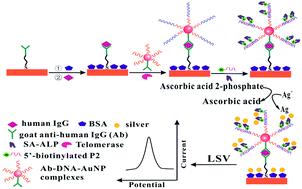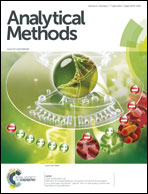A novel electrochemical immunosensor based on dual signal amplification of gold nanoparticles and telomerase extension reaction†
Abstract
A novel electrochemical immunosensor was developed for the detection of human immunoglobulin G (IgG) by using gold nanoparticles (AuNPs) and telomerase extension reaction as dual signal amplification. The immunosensor was implemented based on a heterogeneous sandwich procedure on the gold electrode surface. Goat anti-human IgG (Ab) and telomerase primer P1 co-labelled gold nanoparticles (Ab–DNA–AuNP complexes) was used as secondary antibody for telomerase extension and binding with human IgG. After the telomerase extension reaction, the extension products then hybridized with the biotinylated probe P2, followed by binding of streptavidin-labelled alkaline phosphatase (SA–ALP). The ALP converted ascorbic acid 2-phosphate (AA-P) into ascorbic acid, which reduced the silver ions in the solution into metal silver, leading to the deposition of silver onto the electrode surface. Linear sweep voltammetry (LSV) was used to quantify the amount of the deposited silver which was proportional to the concentration of human IgG. The electrochemical immunosensor showed a dynamic range of 0.1–100 μg mL−1 with a detection limit of 0.02 μg mL−1, acceptable precision, reproducibility and stability. The real human serum sample assay results demonstrated this approach could be used for clinical diagnosis.


 Please wait while we load your content...
Please wait while we load your content...